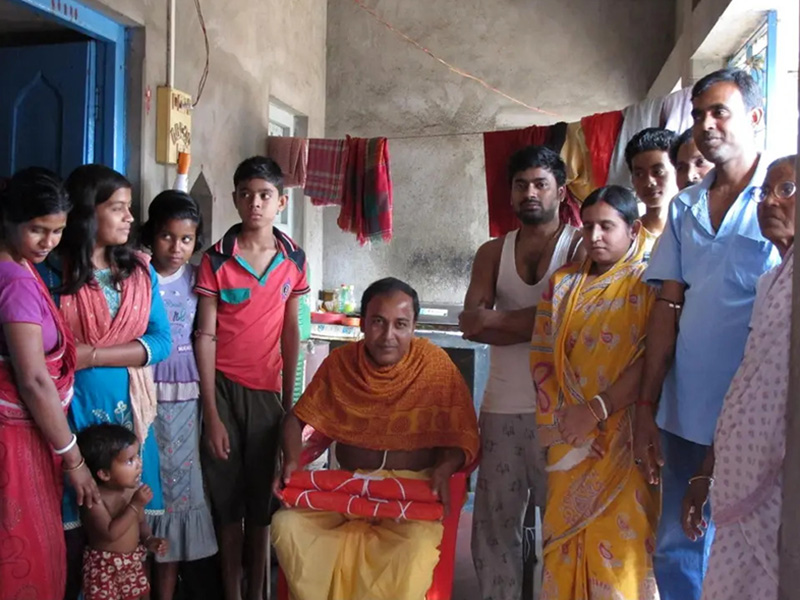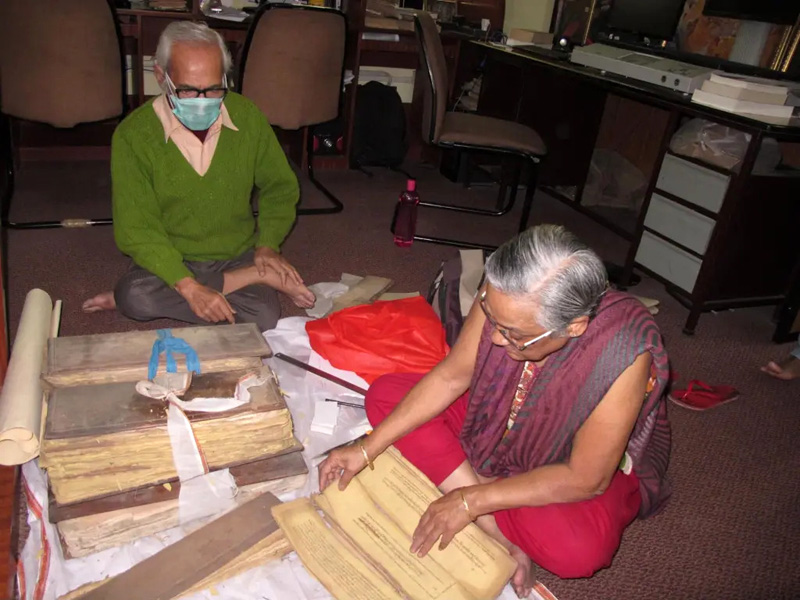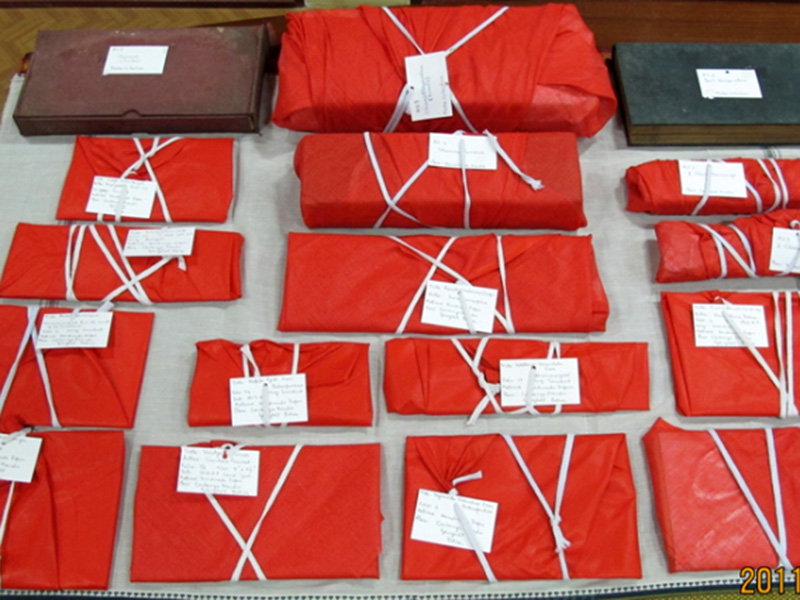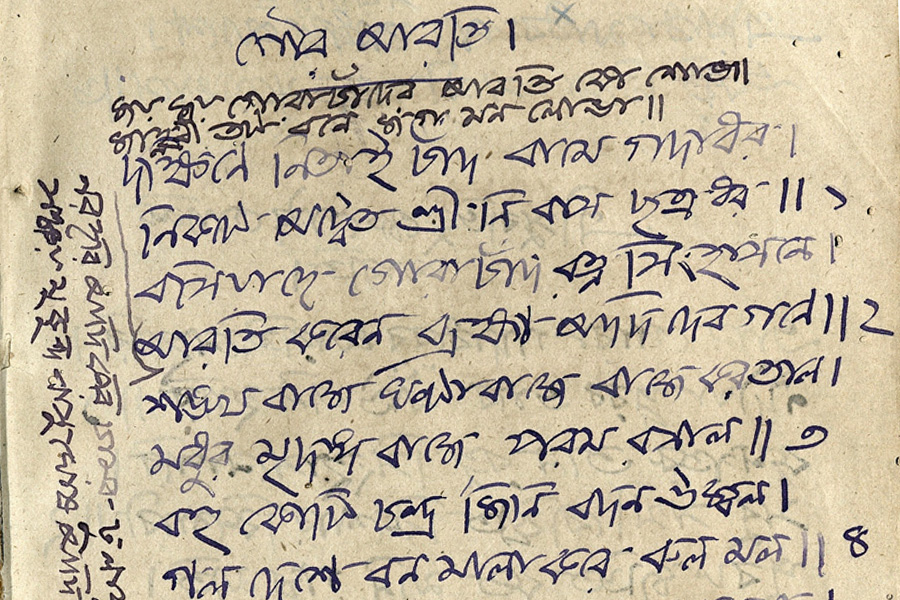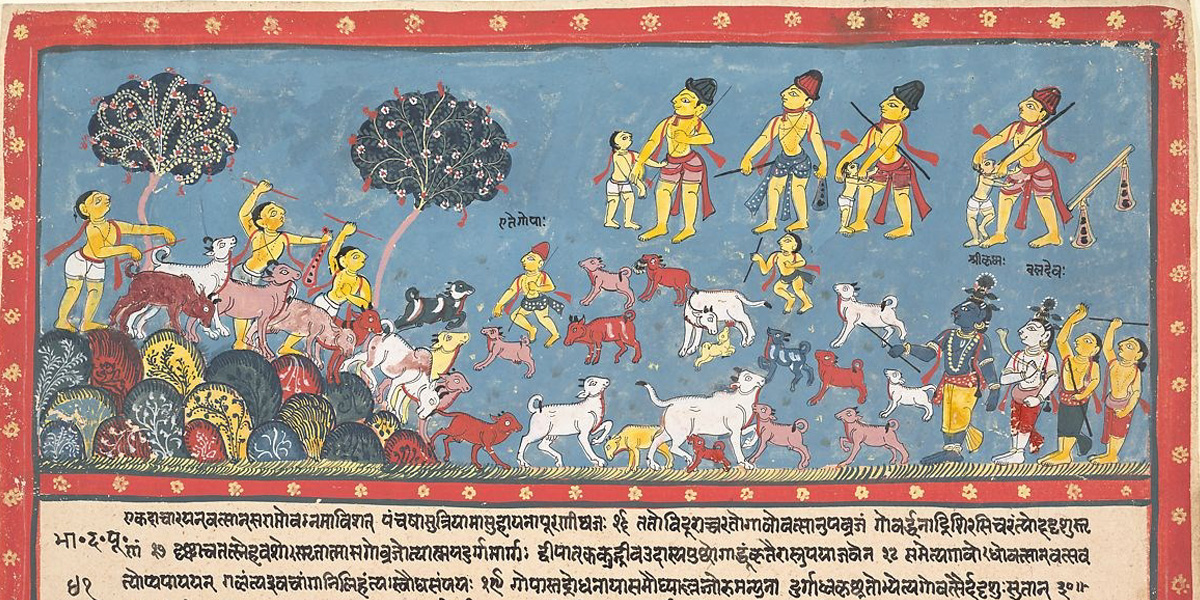
BRC Manuscripts Mission - Field Trips
Introduction
The mission of saving Indian intellectual heritage at
Bhaktivedanta Research Center is to unearth and preserve the
precious wisdom hidden in its ancient manuscripts and books
spread across the remote corners of the country. This
purpose is in line with that of the National Mission for
Manuscripts which was established in February 2003, by the
Ministry of Tourism and Culture, Government of India.
India possesses an estimate of ten million manuscripts,
probably the largest collection in the world. These cover a
variety of themes, textures and aesthetics, scripts,
languages, calligraphies, illuminations and illustrations.
Only 3.3% of these manuscripts have been digitized and the
rest are likely to become extinct unless a serious effort is
made to conserve them. Hence we see our effort as a logical,
radical and urgent response to a very contemporary challenge
- of reclaiming the inheritance contained in manuscripts,
often in a poor state of preservation neglected for decades
and in very poor physical state - insect ridden, fungus
infected or brittle, fading and fragile.
BRC Kolkata's proactive initiatives have helped conduct over fifty manuscript missions across the Indian subcontinent. Owing to its dedicated infrastructure for preserving fragile materials, the BRC Kolkata has received numerous manuscripts as donations. It now has over a thousand manuscripts preserved digitally and around seventy physical manuscripts. This treasure trove of manuscripts has content on a wide-range of subjects including Sahitya, Vyakarana, Vedanta, Vaidya, Agama, Tantra, Nyaya and Mantra Sastra. Most of the manuscripts are in Sanskrit language and the scripts are chiefly in Bengali and Oriya. Some of the texts in the manuscripts are also accompanied by commentaries. A sizable percentage of manuscripts are classified as rare. BRC Kolkata has a temperature-controlled room, fumigation chamber and a fire-proof cabinet to preserve them safely. Some of the fragile manuscripts have also been preserved on zinc-plates.
The key aims of the manuscripts mission program at BRC are:
- Surveying and collecting manuscripts
- Conserving manuscripts in their original form
- Digitizing manuscripts
- Conducting outreach programmes and awareness camps
Field Visits
Since its inception in 2011, the Manuscript Mission team at BRC has visited over 50 locations, including libraries, temples, śrīpāṭas, and private homes in remote areas across the Indian subcontinent.
The team includes an archivist who deciphers and catalogs the manuscripts, a reprographer who digitizes them, and two assistants who help with physical preservation and digital cataloging. Manuscripts are first cleaned with a soft brush, then deciphered and cataloged, recording details such as name, size, location, year, language, and material. For physical preservation, they are covered with deacidified paper and starched red cloth to protect against pests.
The following section describes various visits and the details of the manuscripts digitized during each visit.
.

Vaishnava Research Institute, Halisahar, West Bengal
Vaishnava Research Institute, Halisahar, West Bengal
The BRC team visited the Vaiṣṇava Institute at Hāliśahara, West Bengal, the birthplace of Śrīla Iśvara Purī. Śrīmad Kiśorīdāsa Bābājī, the mahānta at the institute, graciously allowed the team to digitize and catalog manuscripts. Over four days, the team completed the digitization of nearly fifteen manuscripts and brought back some ancient books from the institute's collection.
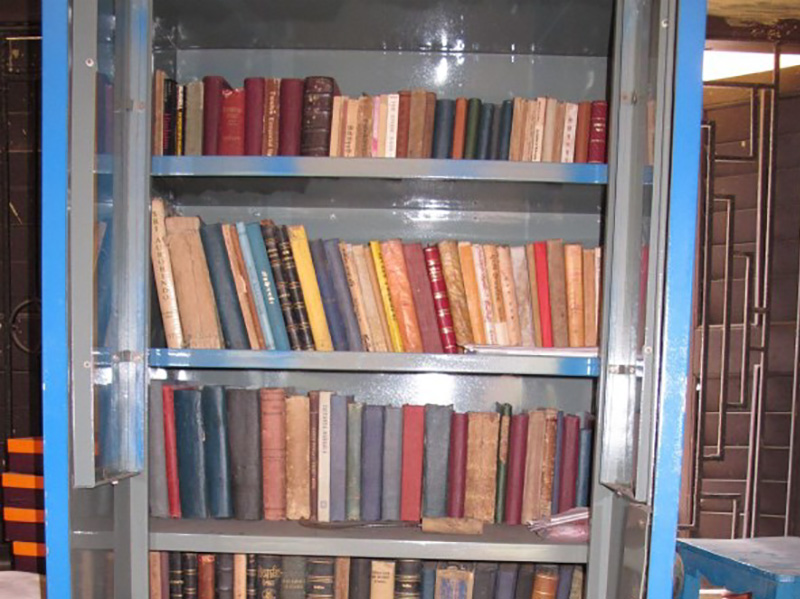
Bangiya Purana Parishad, Shantipur, Nadia, West Bengal
Bangiya Purana Parishad, Shantipur, Nadia, West Bengal
Baṅgīya Purāṇa Pariṣada is an ancient
institution and runs a Sanskṛta Ṭola. The BRC
team received a warm welcome from Paṇḍita
Bibhūtibhūṣana Pāhāḍhī, the in-charge of the
Pariṣada who permitted them to digitize
manuscripts. From the uncatalogued manuscripts
at the institution, the BRC team discovered four
Gauḍīya Vaiṣṇava manuscripts, and digitized
them.
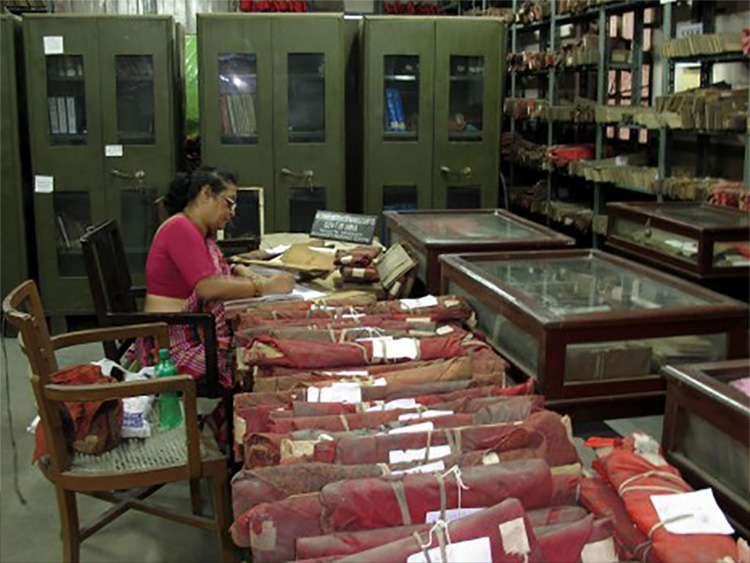
Manuscript Library at Sanskrit College
Sahitya Parishad, Bhabanipara, Nadia, West Bengal
Sāhitya Pariṣada was once inhabited by
erudite paṇḍits. Thus, BRC found manuscripts
primarily on Smṛti (law), along with the
Bhāgavata Purāṇa and some Gauḍīya Vaiṣṇava
manuscripts. The place also housed a
collection of rare, antique items like
swords and idols. The librarian, Pārtha
Prāmānik, warmly welcomed the BRC team and
allowed them to digitize and preserve their
manuscript collection.
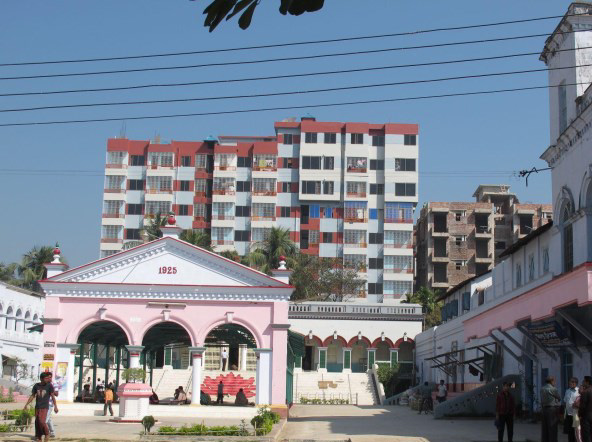
Haribol Kutir, Nabadwip, Nadia, West Bengal
Haribol Kutir, Nabadwip, Nadia, West Bengal
Haribol Kuṭīra was the dwelling place of Śrī Haridāsa Dāsa Bābājī, who left behind many important books that he had published. Among the most notable items from Haridāsa Bābājī's personal collection were two wooden blocks with lead dice: one depicting the map of Gauḍamaṇḍala and the other showing the tour of Śrīmān Mahāprabhu and Nityānanda Prabhu in India. These maps were used by Śrī Haridāsa Dāsa Bābājī in his book Vaiṣṇava Abhidhāna. Rasikānanda Dāsa, the in-charge of this place, showed the BRC team around and shared the collection of books there.
Wooden blocks used by
Haridasa Dasa
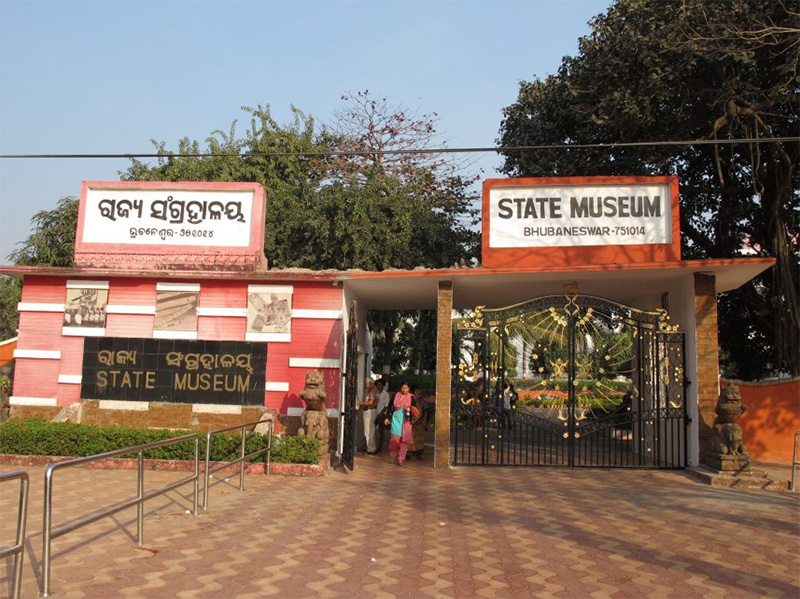
Gauranga Tola Mandir, Navadvip, Nadia, West Bengal
Gauranga Tola Mandir, Navadvip, Nadia, West Bengal
Śrī Gaurāṅga Ṭola Mandira in Navadvīpa holds great spiritual significance, as it is maintained by the descendants of Śrī Viṣṇupriyā Devī. Since she had no children, she adopted her brother's son, and his descendants now continue the service to Dhāmeśvara Śrī Gaurāṅga. The temple was once a center for Sanskrit studies and is currently led by Śrī Sudhīna Gosvāmī as the mahānta.
This temple is especially renowned for the ancient manuscript of the tenth canto of the Bhāgavata written by Śrī Gadādhara Paṇḍita, with Mahāprabhu's own handwritten comments on each folio. This manuscript is still being worshiped daily alongside the deities. Sudhīna Gosvāmī kindly permitted the BRC team to digitize this invaluable manuscript, making it an invaluable treasure of the BRC. Additionally, several other Gauḍīya Vaiṣṇava manuscripts from the temple's library were digitized.
Pictures to add Gauranga
Tol Mandir, The deity of Nimai Pandit (known
later as Sriman Mahaprabhu) at Gauranga Tol
Mandir, Manuscript Library at Gauranga Tol
Mandir, BRC Team working at Gauranga Tol Mandir,
BRC Team cataloging the manuscripts at Gauranga
Tol Mandir.
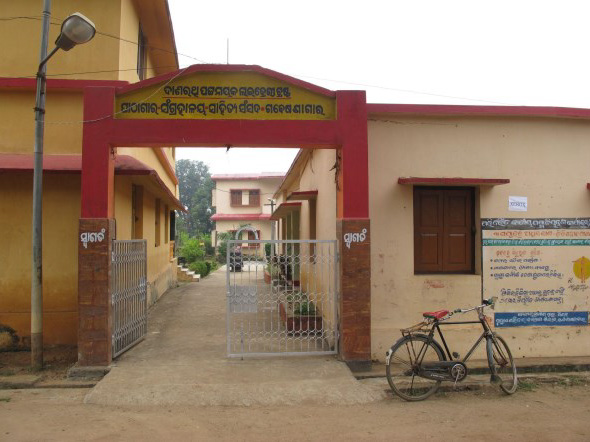
Srikhanda Chittaranjan Pathmandir Library, Bardhaman, West Bengal
Srikhanda Chittaranjan Pathmandir Library, Bardhaman, West Bengal
Śrīkhaṇḍa in Bardhamāna is the Śrīpāṭa of Śrīla Narahari Sarkāra Ṭhākura. The BRC team met the elderly descendant of Sarkāra Ṭhākura there, who encouraged BRC’s preservation work across India. The team visited all the temples in Śrīkhaṇḍa and met with Uttam Sengupta, the librarian of Śrīkhaṇḍa Cittarañjana Paṭhamandira Library.
The library, though relatively new, has a substantial collection of manuscripts. BRC not only digitized the Gauḍīya Vaiṣṇava manuscripts there, but also deciphered all the manuscripts and labeled the bundles. Over two days, the team digitized over fifty manuscripts.
Pictures to be attached-
The aged descendent of Narahari Sarkar Thakur,
Entrance to Sripat Sri Khanda , The deities
worshipped by Sri Narahari Sarkar Thakur,
Srikhanda Chittaranjan Pathmandir Library,
Manuscript Library at Srikhanda Chittaranjan
Pathmandir Library.
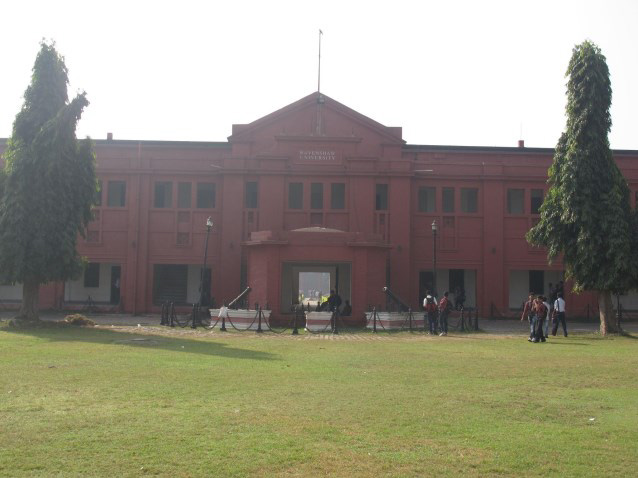
Lal Durga Temple, Navadvip, Nadia, West Bengal
Lal Durga Temple, Navadvip, Nadia, West Bengal
Śrī Kumāranātha Bhaṭṭācārya, formerly a veteran professor at the Vidyāsāgara College in Navadvīpa, was the temple in-charge. During BRC’s visit, his eldest son showed the BRC team some manuscripts in their house–all based on Smṛti. He recounted how his father had rescued these manuscripts during a flood in Navadvīpa. The team was amazed to see that the writing on these manuscripts had not faded despite the passage of many years.
The BRC team digitized some
of these manuscripts, treated them with care,
and arranged them on the shelves. Śrī Kumāra
Bhaṭṭācārya also recommended that the team visit
the General Library of Navadvīpa.
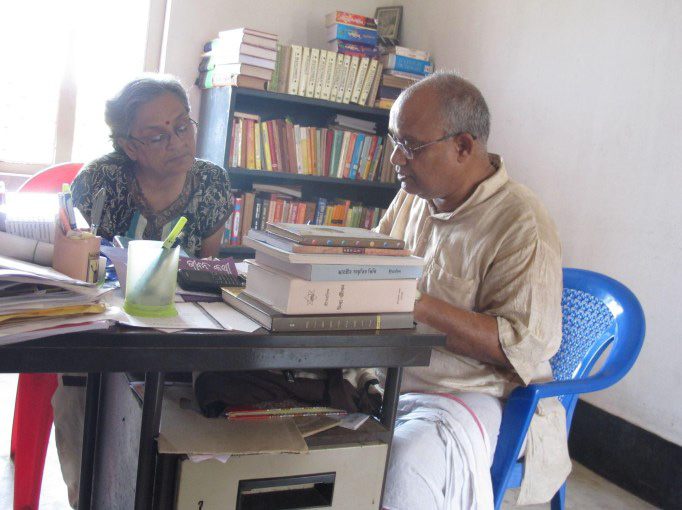
Puratattva Parishad, Nabadwip, Nadia, West Bengal
Puratattva Parishad, Nabadwip, Nadia, West Bengal
The BRC team visited Purātattva Pariṣada in Navadvīpa, where they discovered a manuscript of Raghuvaṁśam by Kālidāsa, copied in the year 1798. Given its age, the team digitized this valuable manuscript.
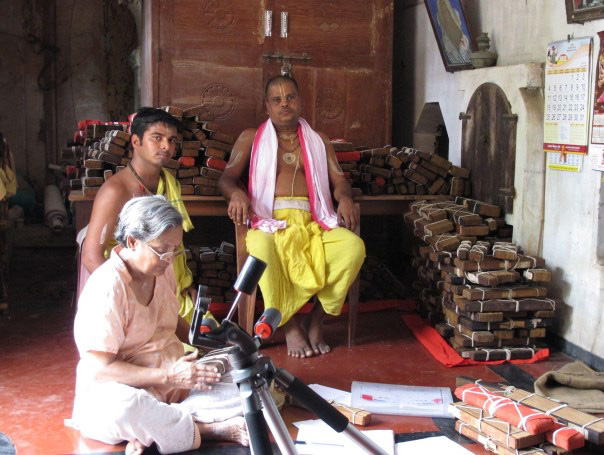
Dwijendra Pathagar, Krishna Nagar, Nadia, West Bengal
Dwijendra Pathagar, Krishna Nagar, Nadia, West Bengal
Dvījendra Pāṭhāgāra is a renowned and well-reputed library in Krishnanagar. The librarian, Mr. Apurba Kundu, was very generous. The BRC team found a large number of manuscripts there, including an impressive collection of the Ṛg Veda.
The team digitized some manuscripts from this library, and as a gesture of gratitude, donated books written by His Divine Grace Srila A.C. Bhaktivedānta Swami Prabhupāda.
Pictures to be attached of
Dwijendra Pathagar, Manuscripts and books at
Dwijendra Pathagar
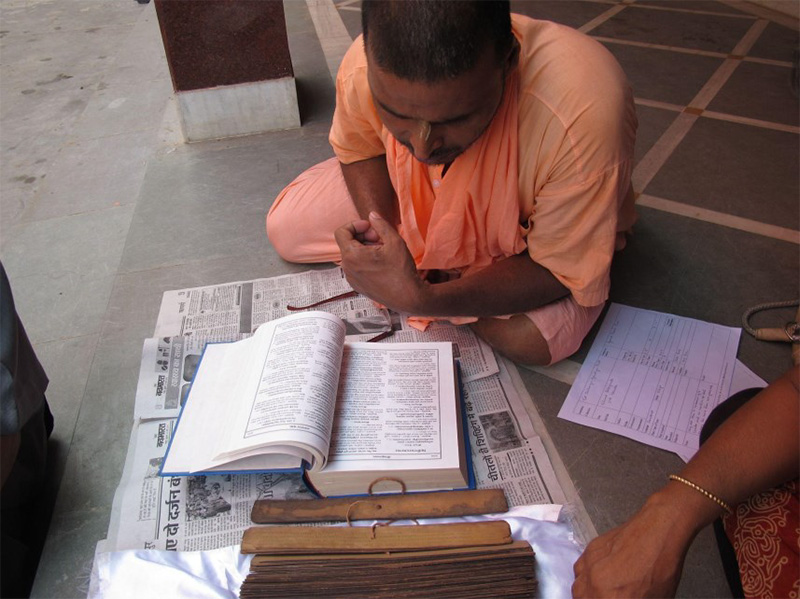
Public Library, Krishna Nagar, Nadia, West Benga
Public Library, Krishna Nagar, Nadia, West Bengal
The BRC team successfully digitized
approximately six manuscripts from here. The
in-charge, Śrī Rabindranātha Biswas, allowed the
team to see their manuscript collection, which
included manuscripts of Śrī Caitanya Caritāmṛta
Ādi, Madhya, and Antya līlās. Owing to their
fragile condition, the team took special care in
digitizing them. Additionally, the team
digitized two other valuable manuscripts in the
library.
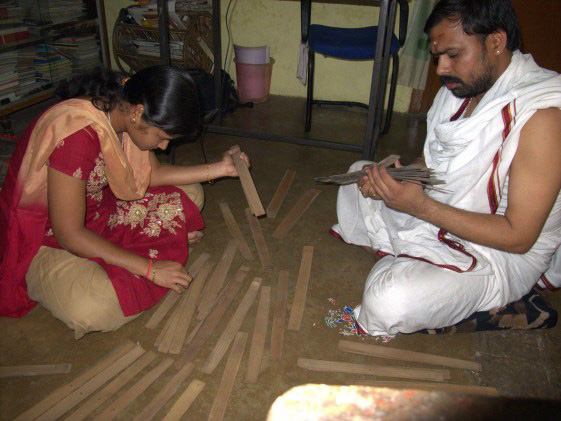
District Library, Krishna Nagar, Nadia, West Bengal
District Library, Krishna Nagar, Nadia, West Bengal
The BRC team visited the District Library and met Smt. Mausumī Chatterjee, the library in-charge. She cordially welcomed the BRC team to see their manuscript collection and allowed the team to digitize and preserve some manuscripts based on the Smṛti.
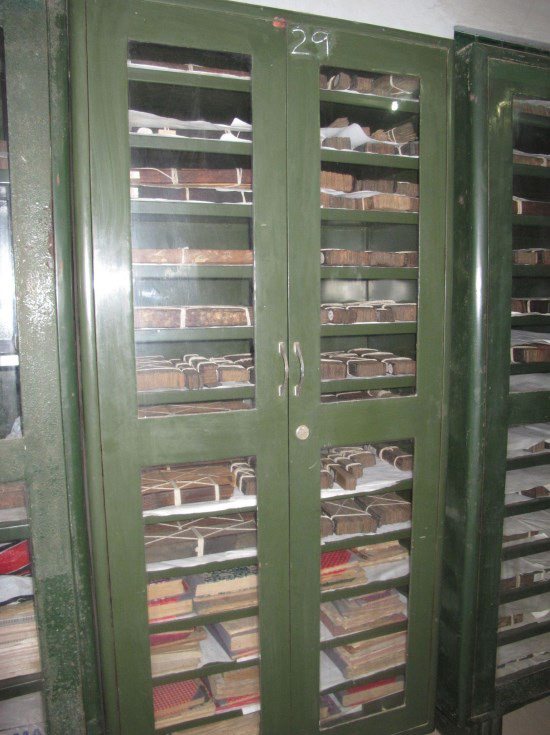
House of Late Mohit Roy, Krishna Nagar, Nadia, West Bengal
House of Late Mohit Roy, Krishna Nagar, Nadia, West Bengal
In Krishnanagar, the BRC team discovered a splendid museum at the residence of the late Mohit Roy. Currently, his son, Monami Roy, looks after the collection, which includes various antique items. He graciously allowed the BRC team to see his collection of Gauḍīya Vaiṣṇava manuscripts and permitted the team to digitize some of them.
As a gesture of gratitude, BRC donated some preservative medicine for their museum along with books written by His Divine Grace Srila A.C. Bhaktivedanta Swami Prabhupāda, which they greatly appreciated.
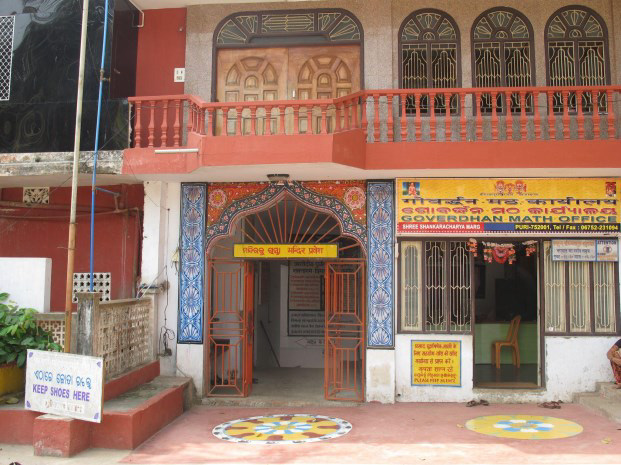
Roypara, Krishna Nagar, Nadia, West Bengal
Roypara, Krishna Nagar, Nadia, West Bengal
The BRC team visited the residence of Asīmānanda Roy in Roypara, Krishnanagar. Asīmānanda Roy was a renowned scholar during his lifetime. The team met his widow, Smt. Mānasī Roy, who mentioned an ancient manuscript at their residence that had not yet been identified. Upon deciphering it, the team found it to be a manuscript of the Mārkaṇḍeya Purāṇa, over 300 years old, written on tree bark. The manuscript was in an extremely fragile condition. The team digitized it and subsequently treated it with preservative medicine. Additionally, the team discovered a very old printed Bhāgavat with pictures printed on a wooden block, which they also digitized.
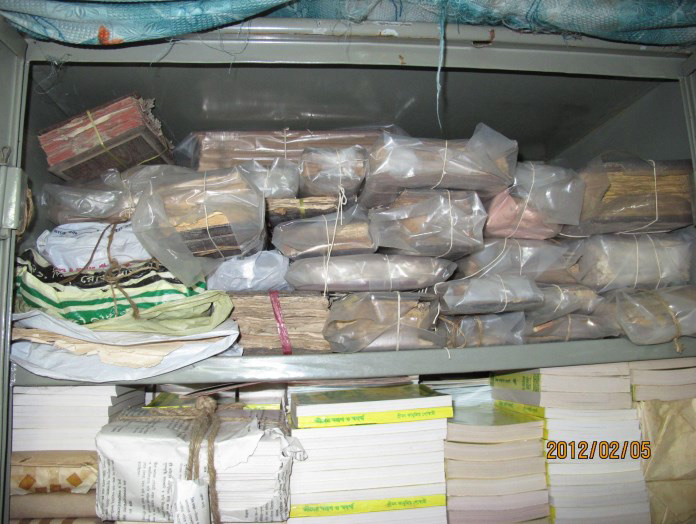
Sripata of Srila Rasikananda Das, West Midnapure, West Bengal
Sripata of Srila Rasikananda Das, West Midnapure, West Bengal
In West Midnapore, on the bank of the river
Suvarṇarekhā, lies the Śrīpāṭa of Śrīla
Rasikānanda Prabhu, a disciple of Śrīla
Syāmānanda Prabhu, in Śrī Gopivallabhapur. The
temple is very old with a beautiful deity of
Syāmasundara.
When the BRC team visited, Śrī Kṛṣṇakeśava Dāsa
Gosvāmī was the mahānta in-charge. His father
was Śrī Govindagopālananda Dāsa Gosvāmī, and
they are descendants of Śrīla Rasikānanda Deva
Gosvāmī.
The temple has a library with an excellent collection of books. The manuscripts were kept at the residence of a partner of the temple, descendants of the brother of the late Govindagopālananda Deva Gosvāmī. The BRC team visited their house and met the widow of Kṛṣṇakeśava Deva Gosvāmī’s uncle. There, the team discovered a valuable collection of Gauḍīya Vaiṣṇava manuscripts and digitized it.
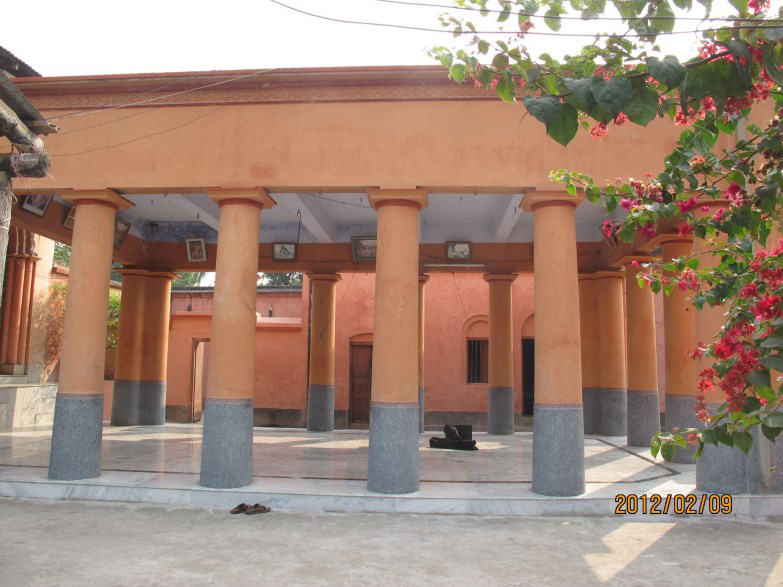
Aksaya Library, Shantipur, Bada Goswamipara, Nadia, West Bengal
Aksaya Library, Shantipur, Bada Goswamipara, Nadia, West Bengal
The BRC team visited the Akṣaya Library in
Shantipur. The librarian, Śrī Taruna Sarkara,
was greatly supportive and helpful. The library,
which is a highly resourceful place for
researchers, serves many readers and houses a
substantial collection of Gauḍīya Vaiṣṇava
manuscripts and books. The BRC team digitized
and preserved nearly twenty manuscripts there.
.
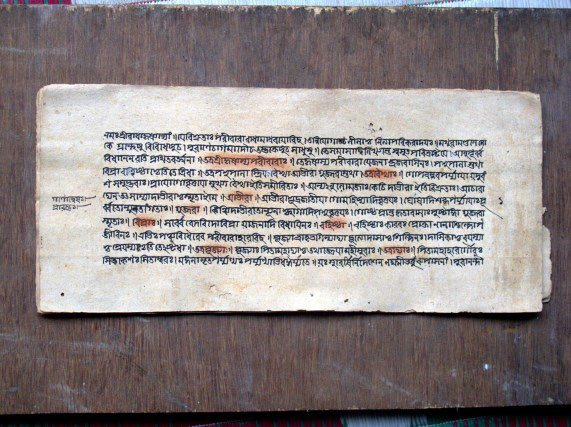
Sudarshanlala Mandir, Nabadwip, Pratapnagar, West Bengal
Sudarshanlala Mandir, Nabadwip, Pratapnagar, West Bengal
Pratāpnagara is a place in Nabadwip where the temple of Sudarśanalāla is situated. Srimad Bhagavata Gosvami is the owner of the temple and also a very good orator on the Bhāgavat. The deity of Śālagrāma Śilā named Sudarśanalāla Jīu is worshiped in a very big temple.
The BRC team found that Bhāgavat Gosvāmī had
a vast collection of Vaiṣṇava books along with
some manuscripts. The team successfully
digitized those Vaiṣṇava books and manuscripts
from his collection.
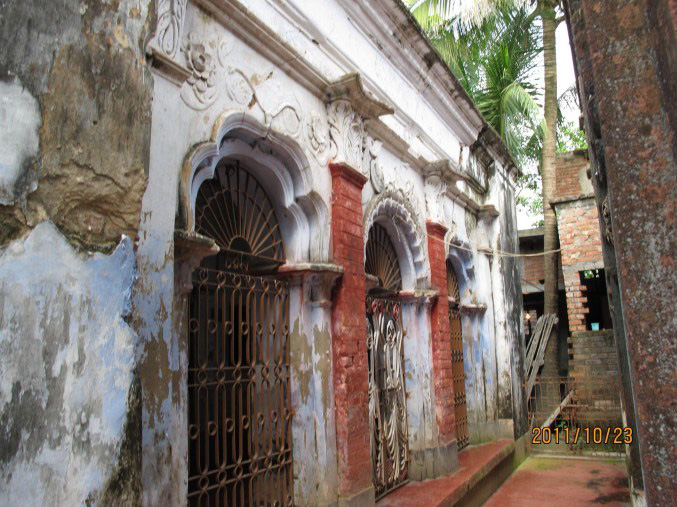
Bally Sadharan Granthagar, Howrah, West Bengal
Bally Sadharan Granthagar, Howrah, West Bengal
On the bank of the Ganges in the Howrah district lies the Bāli Sādhāraṇa Granthāgāra. The BRC team met the librarian, Mrs. Bhabānī Banerjee, who warmly welcomed the team to see their manuscript collection. After perusing the catalog, the team identified a few Vaiṣṇava manuscripts and digitized them. To complete the digitization work, the BRC team visited the place twice.
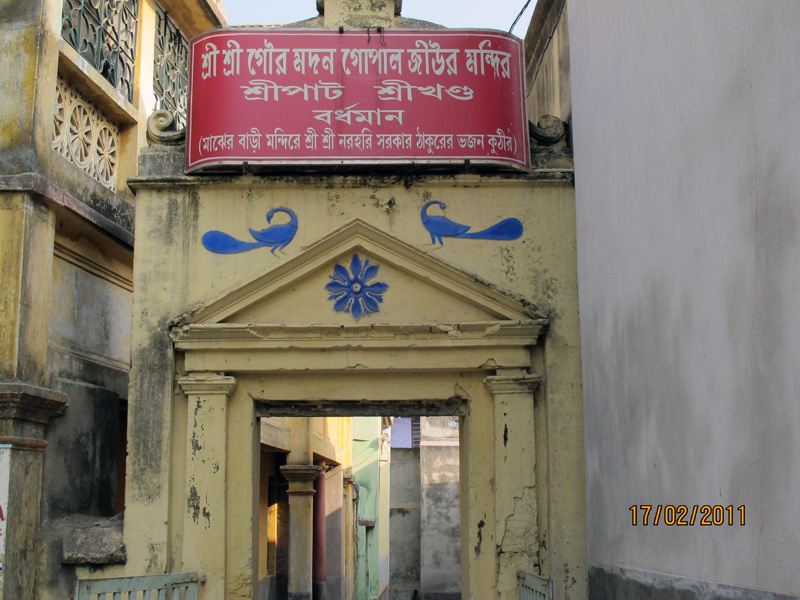
Hooghly, Chandan Nagar Pustakagar Library, Bag Bazar, G.T. Road, West Bengal
Hooghly, Chandan Nagar Pustakagar Library, Bag Bazar, G.T. Road, West Bengal
The Candana Nagara Pustakāgāra is a century-old library. The BRC team were delighted to find a few manuscripts on Gauḍīya Vaiṣṇava literature there. Mrs. Swapna Banerjee, the librarian, graciously allowed the team to digitize them. This library boasts a remarkable collection of books and attracts a considerable number of readers.Alamkara Kaustubhah by Kavi Karnapura Gosvami.

Bansberia Public Library, Hooghly, West Bengal
Bansberia Public Library, Hooghly, West Bengal
The Bāṅsbeḍiyā Public
Library in the Hooghly District is an old
institution with a remarkable collection of
books. Mr. Svapan Dey, the librarian, warmly
welcomed the BRC team who digitized the
manuscripts in the library.
Bāṅsbeḍiyā is renowned for the Haṁseśvarī Kālī
Temple, which once belonged to the local king.
The temple is situated within the premises of
the king's palace, although the palace itself
has fallen into disrepair.

Sripata of Srila Gadhadhar Pandit ,Murshidabad, Bharatpur, West Bengal
Sripata of Srila Gadhadhar Pandit ,Murshidabad, Bharatpur, West Bengal
Bharatpura in Murshidabad is the Śrīpāṭa of Śrīla Gadādhara Paṇḍita. During their visit, the BRC team discovered one part of Śrīmad Bhagavad Gītā written by Gadādhara Paṇḍita, preserved in the temple within a glass box. Remarkably, one folio contained handwritten comments by Śrī Caitanya Mahāprabhu. However, many folios were broken at the corners and not laminated properly.
The manuscript itself was written on tree bark. Additionally, a descendant of Gadādhara Prabhu, Śrī Praṇava Gosvāmī, had some manuscripts on the Bhāgavat and other subjects at his residence. He warmly welcomed the BRC team to digitize and preserve those manuscripts.
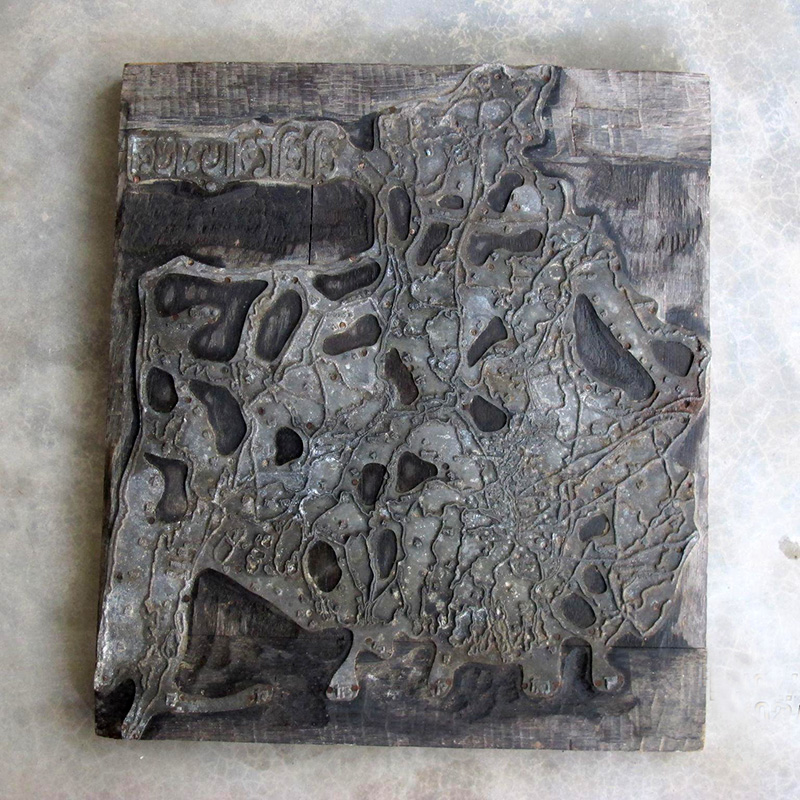
Sri Chaitanya Mandir, Gaighata, Patna, Bihar
Sri Chaitanya Mandir, Gaighata, Patna, Bihar
This is an ancient temple and is said to have been visited by Śrī Caitanya Mahāprabhu. The BRC team met with Śrī Kiśorīramaṇa Gosvāmī, who was overseeing the temple. However, the manuscripts were in a fragile condition.
Kiśorīramaṇajī welcomed the team’s desire to digitize and preserve the manuscripts. The BRC team not only digitized the manuscripts, but also arranged them in steel almirahs, each with individual tags, and created a catalog of manuscripts.
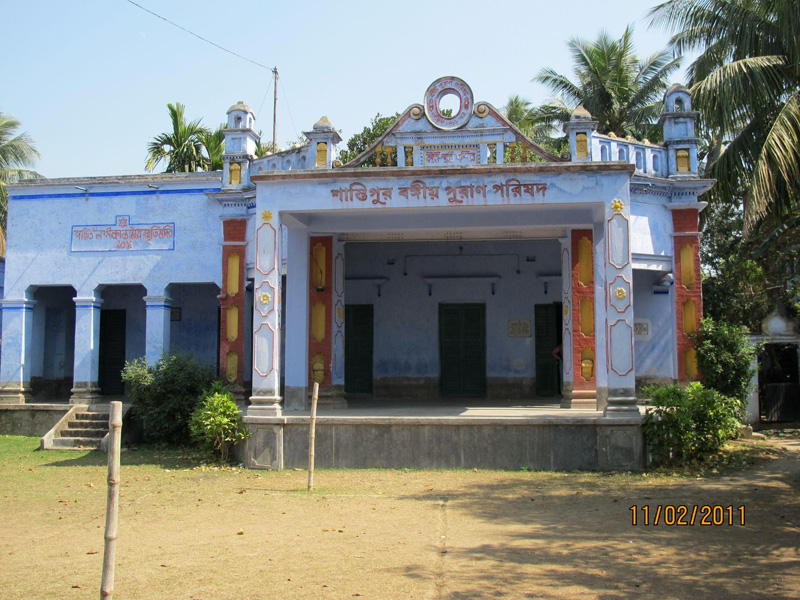
Sanskrit Sahitya Parishad, Kolkata, West Bengal
Sanskrit Sahitya Parishad, Kolkata, West Bengal
Sanskrit Sāhitya Pariśada is a very old library with a large collection of manuscripts. Most of the manuscripts were on various Sanskrit works by renowned Paṇḍitas. Additionally, there were also some manuscripts on Vaiṣṇava subjects, including the Rāmāyaṇa, Mahābhārata, and the Purāṇas. With the permission of the secretary of the library, the BRC team digitized approximately 36 manuscripts there.

Manuscript digitisation and preservation done by BRC Team at Sahitya Parishad
Sri Sri Gaura Kishor Shanti Kunja, Prachin Mayapur, Nadia, West Bengal
At Prācīna Māyāpura, south of Nabadwip, lies the Śrīpāṭa of Śrīmad Kānupriya Gosvāmī. The temple has the deity of Śrī Gaura Rāi and has also preserved the Khuntī of Rāmāi. Śrī Kiśora Rāi Gosvāmī, the mahānta, oversees the temple. The temple had an extensive collection of manuscripts and the mahānta requested the BRC team to initiate the process of preserving and cataloging them. The BRC team undertook the preservation, digitization, and cataloging of those manuscripts.
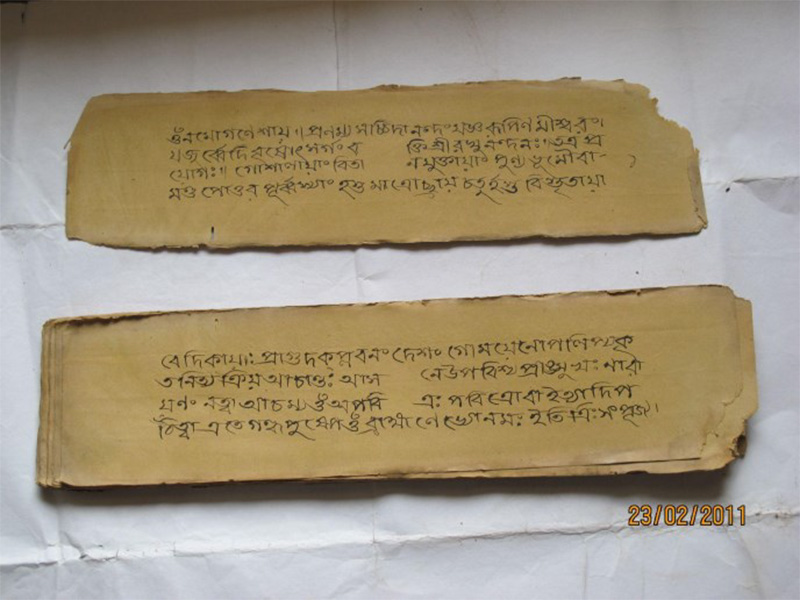
Bada Akhada, Gantala Road, Navadvipa, Nadia, West Bengal
Bada Akhada, Gantala Road, Navadvipa, Nadia, West Bengal
At Gantala Road in Nabadwip is Baḍa Ākhaḍa, where the deity of Sri Sri Rādhā Syamasundara Jī presides. Śrī Rāmasundara Mukhopādhyāy, the mahānta, had a collection of manuscripts. The BRC team digitized, cataloged, and preserved these manuscripts, completing the digitization of approximately eighteen manuscripts.

Nityananda Gadi, Sringarvat, Vrindavan, Uttar Pradesh
The BRC team visited the temple of Śrī Nityānanda Prabhu in Śrīṅgāravaṭa and saw the ‘Khuntī’ of Śrī Nityānanda Prabhu and the chanting beads of Śrī Jīva Gosvāmī. The mahānta of the temple, Śrī Anupam Gosvāmī, had heaps of manuscripts in a fragile condition at his residence. The BRC team organized the manuscripts and digitized some of them. In addition to complete manuscripts, there were also many loose folios, from which the team was able to successfully collate and compile some complete manuscripts.
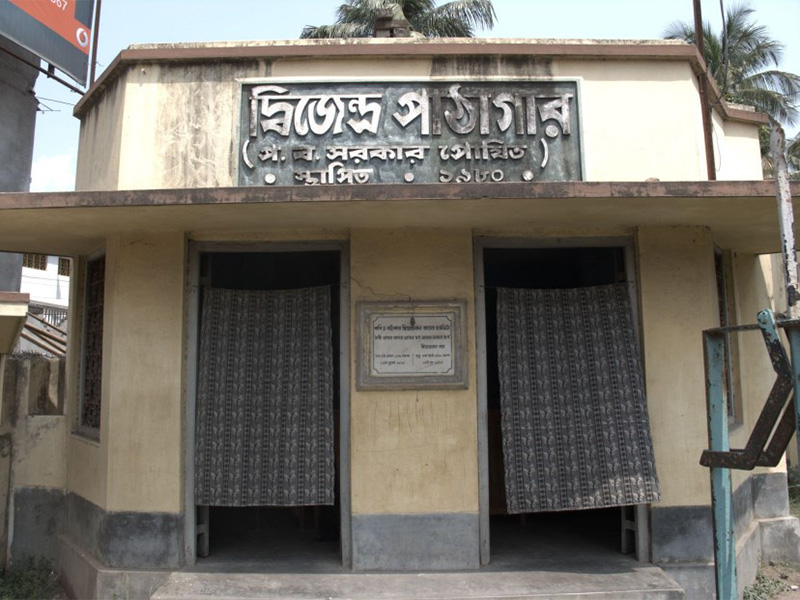
Govindaji Temple, Jaipur, Rajasthan
The BRC team visited the Govindajī Temple and met the mahānta, Añjana Kumāra Gosvāmī, the son of the late Pradyumna Gosvāmī. The manuscripts were initially kept in a room next to the main temple, but due to renovation work, they had been moved elsewhere within the temple premises. The BRC team was able to organize some of the folios into complete manuscripts and subsequently digitized some of them.
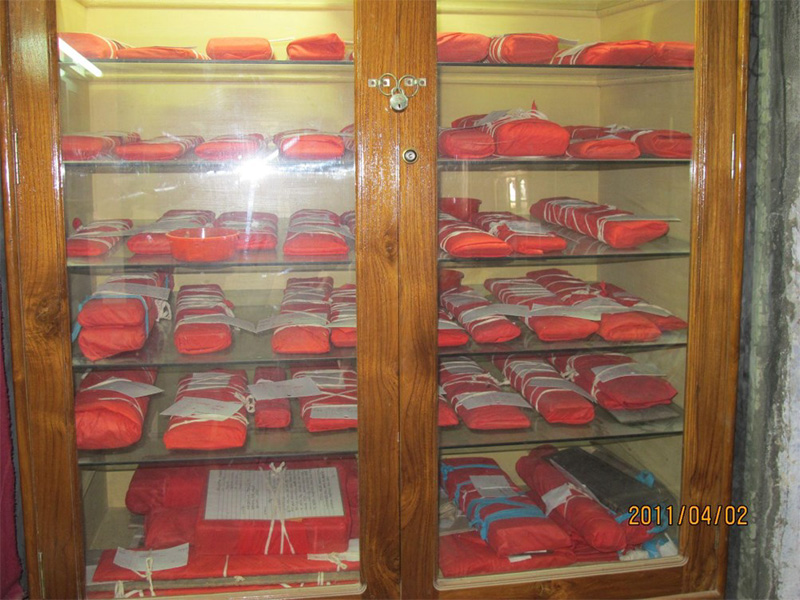
Sri Chaitanya Gaudiya Math, Grand Road, Puri, Odisha
Sri Chaitanya Gaudiya Math, Grand Road, Puri, Odisha
The Śrī Caitanya Gauḍīya Maṭha, located on the grand road of Purī, is the sacred birthplace of His Divine Grace Śrīla Bhaktisiddhānta Sarasvatī Ṭhākura Prabhupāda. During their visit, the BRC team met Śrī Suddhādvaitī Mahārāja, who showed them a manuscript that he had received but could not decipher. The team discovered it to be a manuscript of the 11th Canto of Śrīmad Bhāgavatam–very old and consisting of 200 folios written in the Odiya script. It appeared to be at least 400 years old and was written on palm leaves. The BRC team very carefully digitized the manuscript.
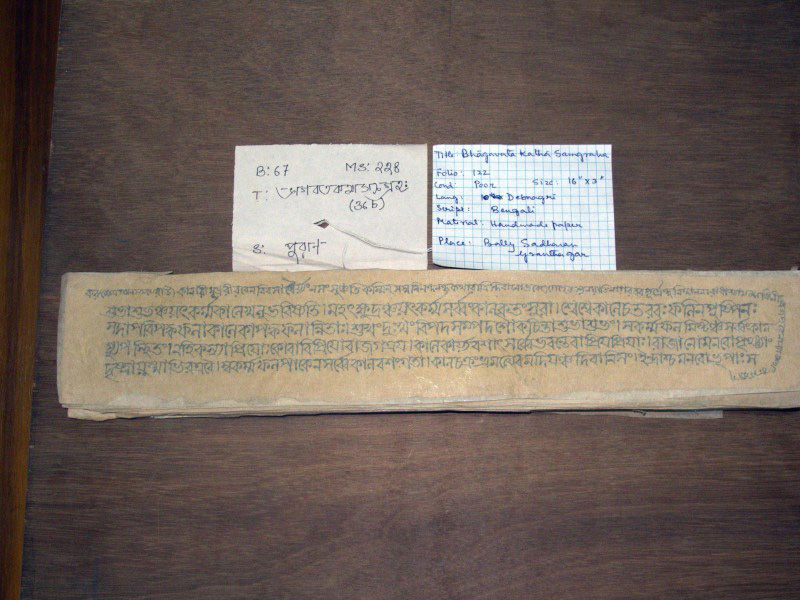
Odiya Math, Puri, Odisha
Odiya Math, Puri, Odisha
On the west side of the Jagannath Temple is the renowned Odiya Matha. They had a huge collection of manuscripts mostly on palm leaves and tree bark, written in Odiya language. The mahānta of the temple kindly permitted the BRC team to proceed with the process of digitization. Since none of the team members knew the language, the team took assistance from a devotee of that temple, Krishna, who helped them decipher the manuscripts. The team then digitized the manuscripts which were able to be deciphered.
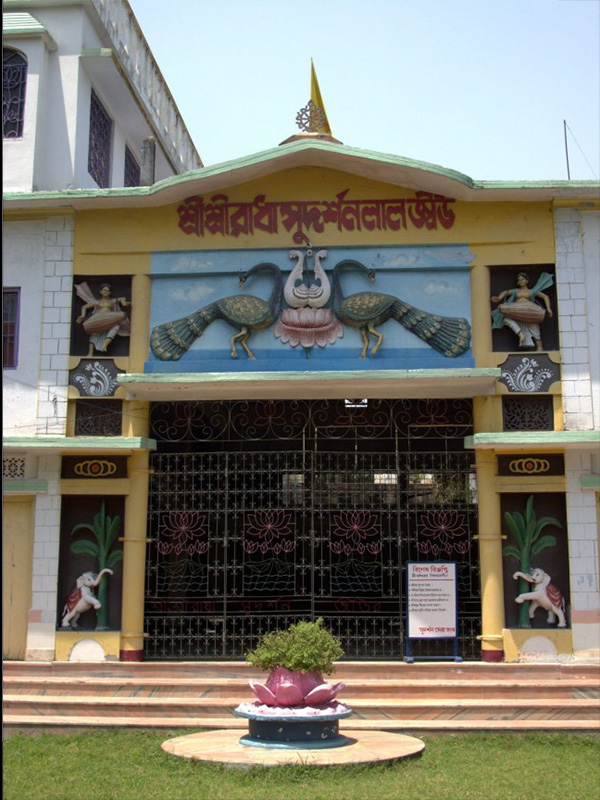
Kedarnath Research Library, Kedar Gauri Marg, Bhubaneshwar, Odisha
Kedarnath Research Library, Kedar Gauri Marg, Bhubaneshwar, Odisha
The BRC team visited the Kedāranāth Research Library in Bhubaneswar and met the librarian, Śrīmatī Binodinī Sahoo. The library had some handwritten manuscripts on Gauḍīya Vaiṣṇavism. The language was Sanskrit but the script was Odiya. The BRC team digitized about thirteen manuscripts from this library.:
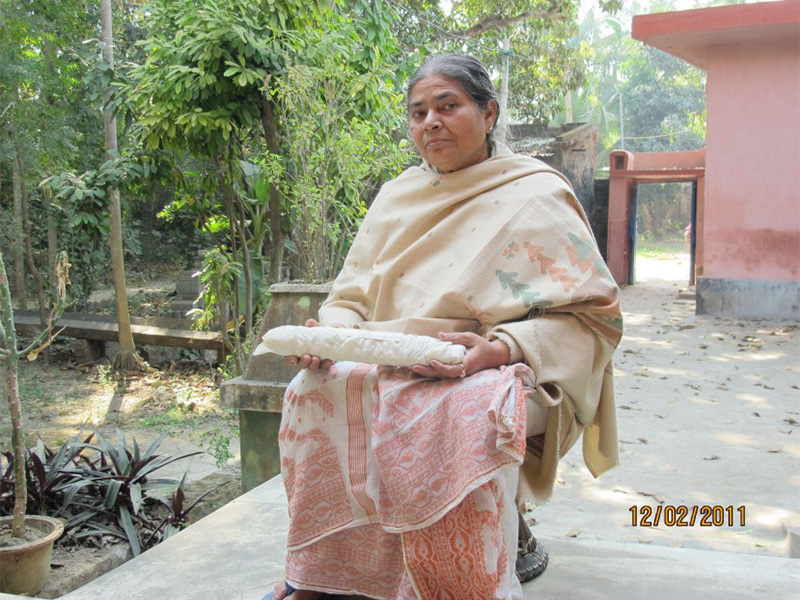
Sankaracharya Govardhan Peeth, Sankaracharya Marg, Balisahi, Puri, Odisha
Sankaracharya Govardhan Peeth, Sankaracharya Marg, Balisahi, Puri, Odisha
The BRC Team visited the Śankarācārya Govardhana Pīṭha and digitized some manuscripts from their collection namely, the Śrimad Bhāgavata 10th Canto and the Vaiṣṇava Vrajabhāṣā.
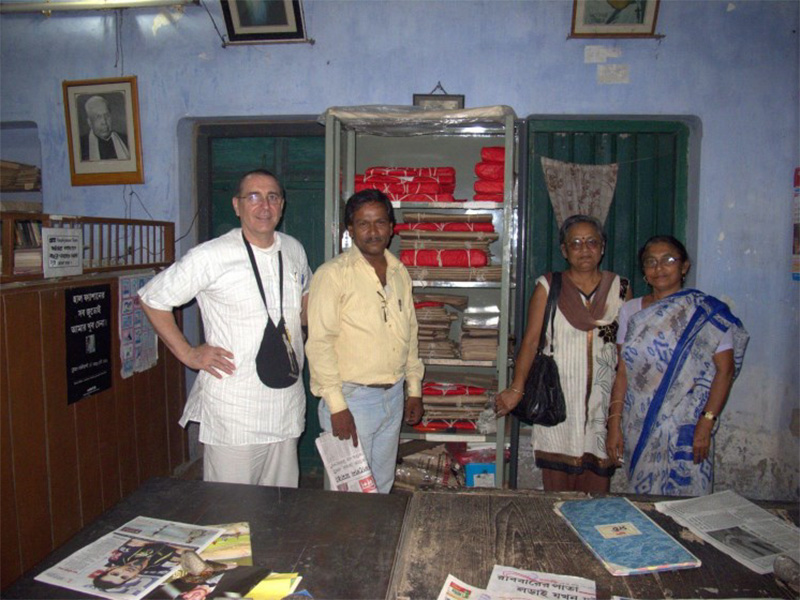
Jagannath Sanskrit University, Puri, Odisha
Jagannath Sanskrit University, Puri, Odisha
The BRC team visited the
Jagannātha Sanskrit University in Purī and met
with Śrī Vraja Kiśore Swain, who warmly welcomed
the team and showed them the collection of
manuscripts there. The team digitized a few
manuscripts from this collection.
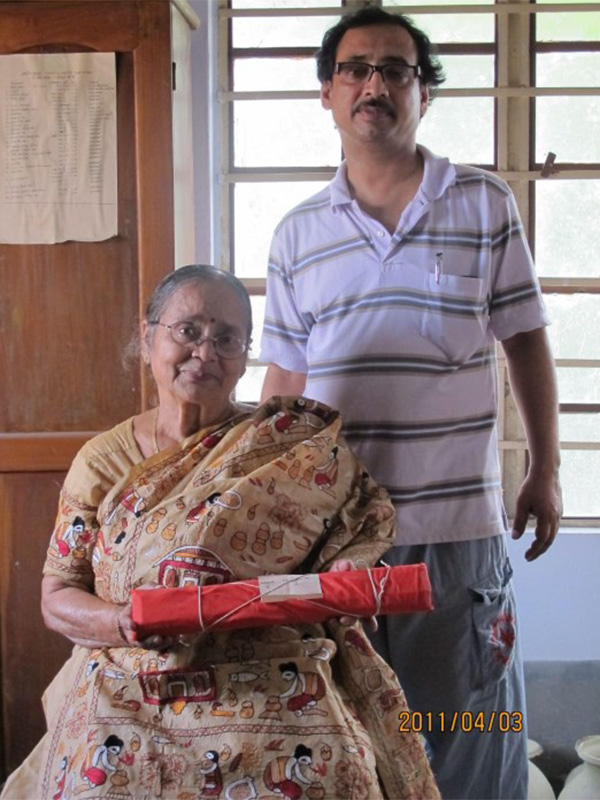
Rsividya Indological Library, Cuttack, Odisha
Rsividya Indological Library, Cuttack, Odisha
Upon visiting this library, the BRC team was introduced by Professor Swain to one of his students, Bibhūtibhūṣaṇa Mahāpātra, who lived in Cuttack. Bibhūti had a collection of manuscripts at his residence, preserved under the name of Ṛṣividyā Indological Library. He invited the team to his house to see the collection. Upon arriving, the BRC team digitized some manuscripts, all of which were written on palm leaves in the Odiya language.
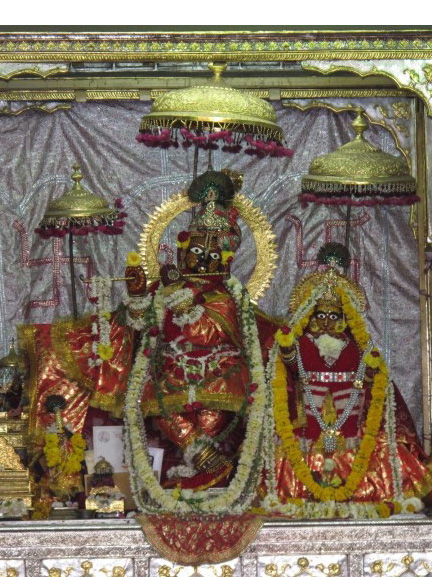
Sri Radha Govindaji of Jaipur
Ravenshaw University, Cuttack, Odisha
The BRC team visited the Ravenshaw
University, and after a visit to the library,
the management authorities granted permission
for the team to digitize the manuscripts. The
team successfully digitized approximately 20-25
manuscripts during their visit.
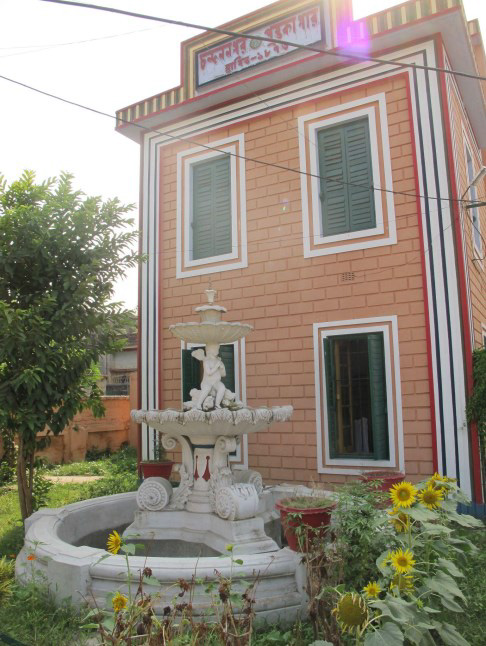
Dasarathi Pattanayak Library, Udaypur, Nayagarh, Odisha
Dasarathi Pattanayak Library, Udaypur, Nayagarh, Odisha
From Cuttack, the BRC team traveled to
Udaypur Nayagarh, to see the collection of
Daśārathi Paṭṭanāyaka. Upon arrival, Daśārathi
Paṭṭanāyaka’s son warmly welcomed the team. They
had a museum showcasing a variety of materials,
along with a collection of books and journals.
Their manuscript library was particularly
remarkable, with all manuscripts written on palm
leaves.
Upon reaching the library, the BRC team
discovered that the Manuscript Mission of
Bhubaneswar was already working there. The BRC
team was able to digitize nearly thirteen
manuscripts from that library.
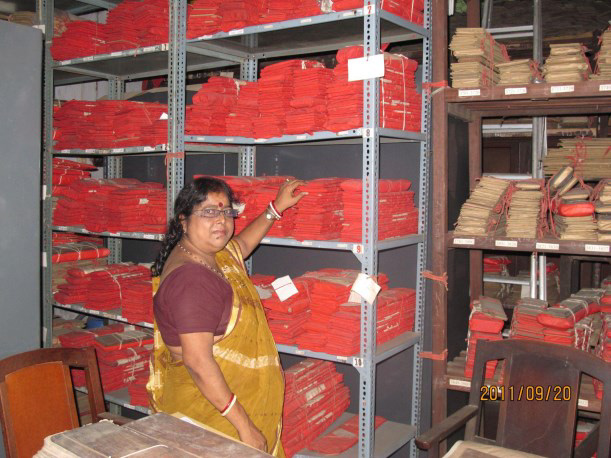
State Museum, Bhubaneshwar, Odisha
State Museum, Bhubaneshwar, Odisha
The Bhubaneswar State Museum is famous for its collection of manuscripts. The curator, Mrs. Bhagyalakshmi, welcomed the BRC team, as did the Superintendent of the Museum, who willingly permitted the team to work in the museum library.
The team digitized many Gauḍīya Vaiṣṇava manuscripts. Among these, they digitized a manuscript on cow preservation, which is said to have been written by Sahadeva, the youngest Pāṇḍava brother. Although the manuscript was copied later, its script was in Odiya.
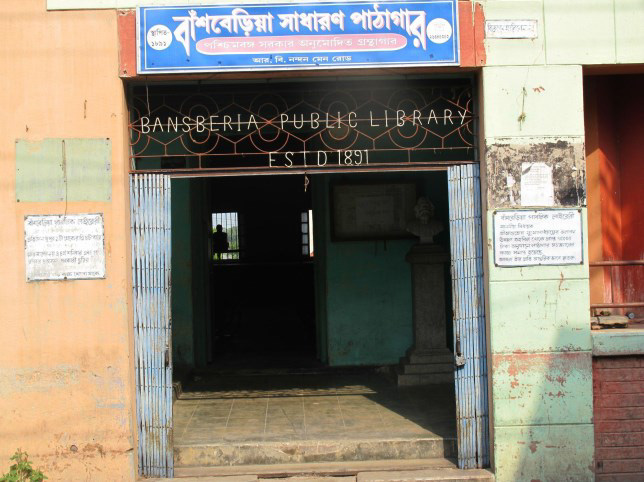
Isvar Pathshala Library, Comilla, Bangladesh
Isvar Pathshala Library, Comilla, Bangladesh
The BRC team visited the library and was amazed to see the extensive collection of 9,000 manuscripts. With permission from the library in-charge, Indra Siṅgha, the BRC team digitized and preserved several manuscripts. Among them, the team was fortunate to discover a notable manuscript on astrology, which Śrī Bhaktisiddhānta Sarasvatī Ṭhākura had used for his journal, Jyotiṣtattvam.

Sanskrit College, College Street, Kolkata, West Bengal
Sanskrit College, College
Street, Kolkata, West Bengal
The BRC team visited the Sanskrit College in Kolkata and met with the librarian, who allowed them to review the catalog of manuscripts there. With the librarian’s permission, the team also digitized several Gauḍīya Vaiṣṇava manuscripts.
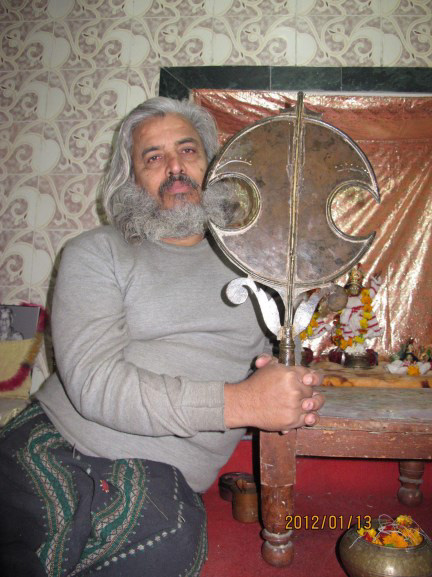
The House of Raja Rajendra Lal Mitra, Beleghata, Kolkata, West Bengal
The House of Raja Rajendra Lal Mitra, Beleghata, Kolkata, West Bengal
Pradyumna Prabhu (Paul Sherbow) introduced us to Kalyani Basu, a member of the family of the Late Rajendralal Basu, the first president of the Asiatic Society. This family, who has a century-old deity of Śrī Balarāma and Revatī, invited the BRC team to one of their house festivals. There, the team met Mrs. Basu’s brother, Mr. Swarup Mitra, who mentioned that they had a collection of manuscripts.
The manuscripts being disorganized, he entrusted the BRC team with the responsibility of arranging them. For fifteen days, the team worked at their house, arranging, preserving, and digitizing the manuscripts. During this process, the team also discovered a very old manuscript of Haribhaktivilāsa in excellent condition.
The team began by cleaning the almirahs where
the manuscripts were stored, and then digitizing
and properly arranging them.
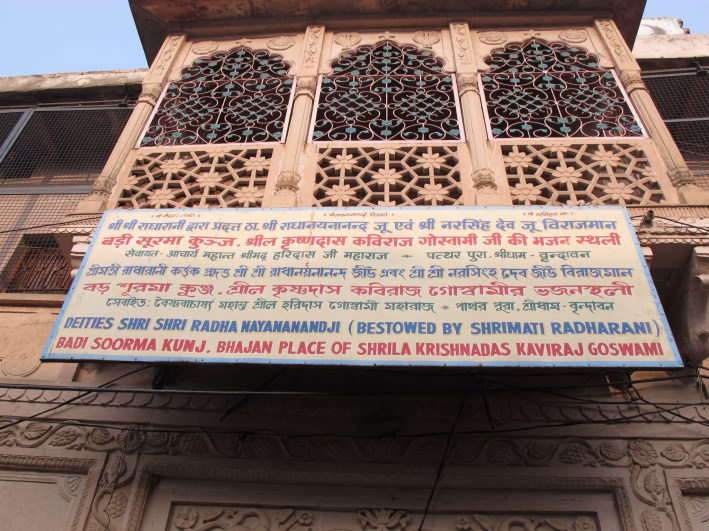
Sadharan Grantha Mandir, Nabadwip, Nadia, West Bengal
Sadharan Grantha Mandir, Nabadwip, Nadia, West Bengal
Sādhāraṇa Grantha Mandira is a library that is more than a century old with an extensive collection of books. Śrī Nishit Banerjee and the ex-librarian Nilotpal Babu requested the BRC team to catalog their manuscripts. The team began the task and successfully cataloged about nine hundred manuscripts.
During the cataloging process, the team found works primarily on Smṛti, Nyāya, Vyākaraṇa, astrology, and medicine. Additionally, there were a few Gauḍīya Vaiṣṇava texts, which the team digitized.
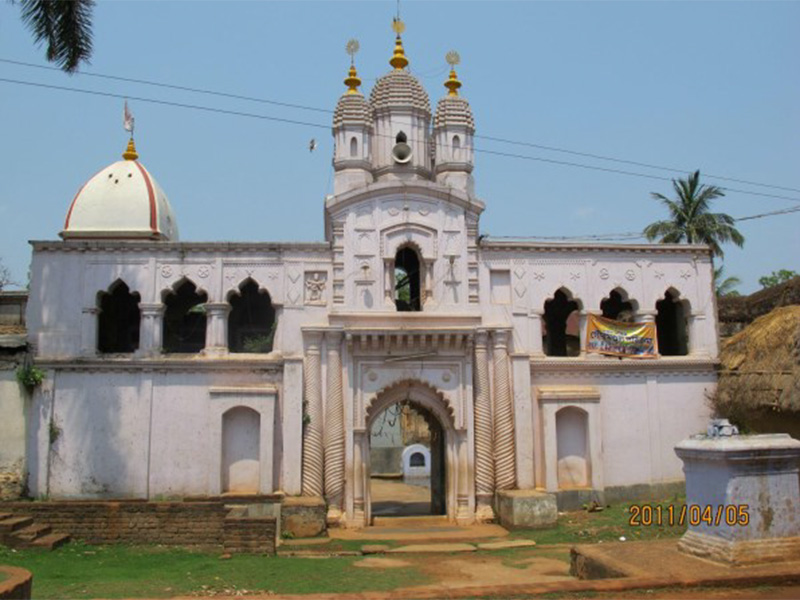
Entrance to the Sripat of Sri Rasikananda Das
House of Manoj Goswami, Bangalore
Śrī Manoj Gosvāmī is the seventeenth generation from the lineage of Śrī Advaita Ācārya in Śāntipura. He possesses a collection of manuscripts from his family lineage that are over a century old. In an act of great generosity, he donated approximately fifty manuscripts to the BRC, which have now been added to BRC’s physical manuscript collection.
The BRC team deciphered these manuscripts and
then proceeded with their preservation,
cataloging, and digitization. BRC is extremely
grateful to Śrī Manoj Gosvāmī ji for his kind
donation and invaluable contribution to its
collection.

Badi Surma Kunj, Vrindavan, Uttar Pradesh
Śrī Raghunātha Bhaṭṭa Gosvāmī and Śrī Kṛṣṇadāsa Kavirāja Gosvāmī performed bhajana at this spot when it was a secluded place. Around four hundred years ago, Śrī Kṛṣṇadāsa Kavirāja Gosvāmī composed Śrī Caitanya Caritāmṛta, a unique gem of devotional literature. He mentioned that the original handwritten Śrī Caitanya Caritāmṛta Mādhya and Antya Līlā by Śrī Kṛṣṇadāsa Kavirāja Gosvāmī is preserved there. Later, his disciple Śrī Mukunda Dāsa Gosvāmī constructed a temple here and established deity worship.
Śrī Prema Dāsa Śāstrī is the mahānta of the temple. He kindly allowed the BRC team to digitize and preserve the manuscripts in their collection.
Badi Soorma Kunj (Bhajan Place of Sri Krsnadas
Kaviraj Goswami), Inside the Temple of Badi
Soorma Kunj, BRC Team preparing to digitize the
manuscripts, Library at Badi Soorma Kunj

House of Sanjay Goswami, Vrindavan
The BRC team visited the house of Śrī Sañjaya
Gosvāmī in Vṛndāvana. Gosvāmī ji has been a
well-wisher of BRC. After visiting BRC’s
Research Library in Kolkata and appreciating
BRC’s efforts in preserving manuscripts, he
graciously allowed the BRC team to digitize and
preserve his collection when the team visited
Vṛndāvana. The team successfully digitized
approximately 18 manuscripts. The BRC team is
also grateful for his assistance during their
tour in Vrindavan, which was invaluable to the
team’s work.

K.C. Sahu's House Collection, Odisha
The BRC team visited and
digitized some manuscripts from the personal
collection of the K. C. Sahu’s House Collection.
Books at K.C.Sahu’s house in Odisha
Chinsuraha Kisore Pragati Sangha Sahar
Granthagar

Vamshidhar Mohanty's House Collection, Odisha
The BRC team visited the house of Śrī
Vaṁīdhara Mohanty and digitized an old
illustrated Bhāgavat Purāṇa.
Folio one of Bhagavat Purana.

Sanskrit College, Sylhet, Bangladesh

Sylhet Sanskrit College, Library of Sylhet Sanskrit College

Bangla Academy, Dhaka
Bangla Academy is an autonomous institution funded by the Bangladesh government to foster the Bengali language, literature and culture, to develop and implement national language policy and to do original research in the Bengali language. The main task of the academy is to conduct research on the Bengali language, culture, and history, and to publish Bengali literary and research work. The BRC team visited the Academy and digitized a few manuscripts there.

Mohiary Public Library, Howrah

Makardaha Saraswat Library, Howrah, West Bengal

Maju Public Library, Howrah, West Bengal

Ariadaha Association Library, Belgharia, West Bengal
The BRC team visited the Ariadaha Association Library in Belgharia and met with the staff. Following a discussion, the librarian gave the team a tour and granted permission to digitize and preserve their collection. Approximately thirty-five manuscripts were digitized.

Kakora Village, Bardhaman, West Bengal
The BRC team visited the rural village of Kākorā in the Bardhamāna district. In this remote village, a local villager had preserved an ancient manuscript for a long time. He recounted how, during a severe flood in 1973, the manuscript floated to their house. The flood was devastating, causing many casualties, so protecting the manuscript was not a priority at the time. It remained underwater for fifteen days. After the flood, the villager dried the manuscript, wrapped it in new clothes, and stored it. Each year, during a local harisabhā, the villagers take the manuscript to the temple, offering vermillion and sandalwood paste, and worship it as a sacred object. Upon the BRC team’s request, they unwrapped the manuscript and showed it to the team. The team deciphered it and discovered it to be Caitanya Maṅgala by Locana Dāsa Ṭhākura, written on handmade paper. Despite being submerged during the flood, the ink had not bled. Some folios were stuck together, but the team carefully cleaned, digitized, and preserved the invaluable manuscript..

House of Dr. Mihir Choudhury Kamilya
The BRC team visited the house of the late Dr. Mihir Choudhury Kamilya, an eminent poet, critic, and writer of West Bengal, and a professor in the Department of Bengali at Burdwan University. His son welcomed the team and showed them the collection of books and manuscripts his father had preserved. He was extremely cooperative and allowed the team to digitize and catalog the manuscripts, making them accessible to readers and scholars.


